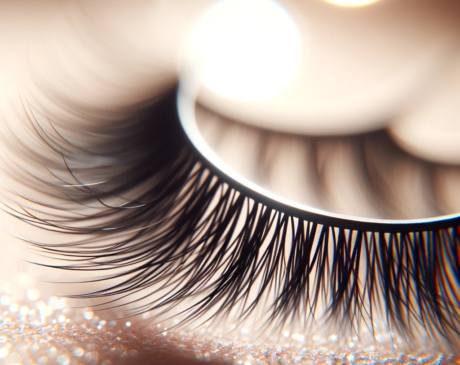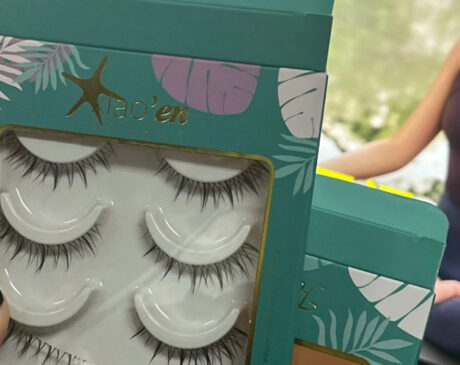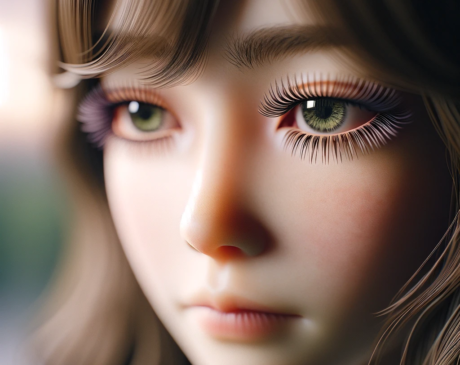Do false lashes go on top or bottom?

False eyelashes have become a cornerstone in the beauty and cosmetics industry, offering a way to enhance and transform one’s appearance dramatically. The journey of false eyelashes from a novel invention to a beauty staple is as fascinating as the variety of lashes available today.
Brief History of False Eyelashes
The concept of false eyelashes dates back to ancient civilizations, but the modern version we know today took shape in the early 20th century. In 1916, director D.W. Griffith wanted actress Seena Owen to have lashes “that brushed her cheeks, to make her eyes shine larger than life.” This request led to the creation of the first false eyelashes, made of human hair woven through fine gauze. Over the decades, false eyelashes evolved, with materials ranging from synthetic fibers to mink fur, becoming accessible and popular among the masses.
Popularity and Modern Trends in Eyelash Extensions
In recent years, the demand for false eyelashes has skyrocketed, thanks to their popularity among celebrities and influencers. Modern trends lean towards a more natural look, with varying lengths and volumes to suit different eye shapes and preferences. Eyelash extensions, a semi-permanent solution, have also gained popularity for their durability and natural appearance, allowing wearers to wake up with perfectly styled lashes every day.
Types of False Eyelashes
With a variety of types available, choosing the right false eyelashes can be daunting. Each type offers a unique look and caters to different preferences and skill levels in application.
Strip Lashes
Strip lashes are the most common type, consisting of a horizontal strip of lashes that is applied to the natural lash line. They come in various lengths, volumes, and styles, from natural to dramatic. Strip lashes are ideal for one-time use or short-term wear and are popular due to their ease of application and removal.
Individual Lashes
Individual lashes offer a more customized and natural look. These lashes are applied one at a time to your natural lashes, giving you control over the fullness and shape of your lash line. They require more precision and patience to apply but result in a more seamless blend with natural lashes.
Magnetic Lashes
Magnetic lashes are a newer innovation in the false lash market. These lashes use tiny magnets along the lash band to attach to a magnetic eyeliner applied along the lash line. They are reusable and considered easier to apply and remove than traditional glue-on lashes, making them a great option for those sensitive to adhesives.
Proper Placement of False Lashes
The placement of false lashes can significantly impact your overall look. Whether on the top or bottom, proper placement is key to achieving a natural and flattering appearance.
Traditional Top Lash Placement
Top lash placement is the most common method of wearing false lashes. It involves attaching the false lashes to your natural upper lash line, enhancing the volume and length of your natural lashes. This method is ideal for adding drama and intensity to the eyes and is suitable for various occasions, from everyday wear to special events.
Emerging Bottom Lash Trends
While less common, applying false lashes to the bottom lash line is an emerging trend. Bottom lashes can add depth and definition to the eyes, creating a balanced and captivating look. This technique is often used in editorial makeup or for a more avant-garde appearance.
How to Apply False Lashes on the Top Eyelid
Applying false lashes on the top eyelid can be intimidating at first, but with practice, it becomes a straightforward process.
Preparing Your Natural Lashes
Before applying false lashes, it’s essential to prepare your natural lashes. Start by cleansing your eyelids to remove any oil or makeup residue. Curl your natural lashes and apply a light coat of mascara, which helps in blending your natural lashes with the false ones.
Step-by-Step Application Guide
1.Measure and Trim: Hold the strip lash against your eyelid and trim any excess from the outer end.
2.Apply Adhesive: Apply a thin layer of lash glue along the band of the false lashes. Wait a few seconds for the glue to become tacky.
3.Place the Lashes: Using tweezers or a lash applicator, place the lash as close as possible to your natural lash line. Start from the center, then adjust the ends.
4.Secure the Lashes: Gently press down on the lashes to secure them in place. Use a lash comb or your fingers to blend them with your natural lashes.
Tips for a Seamless Finish
1.Be patient and allow the glue to dry completely.
2.Avoid heavy eye creams or oily products on your eyelids before application.
3.Practice makes perfect. Don’t get discouraged if your first few attempts aren’t perfect.
4.Use a lash adhesive that dries clear for a more natural look.
5.If needed, apply eyeliner to conceal the lash band and create a seamless transition from false lashes to your natural lash line.
Exploring Bottom False Lashes
The application of bottom false lashes can dramatically change the look of your makeup, offering a unique and often under-explored aspect of eye enhancement. Understanding when and how to use them can open up new possibilities in your beauty routine.
When to Choose Bottom Lashes
Bottom false lashes are ideal for creating a balanced, wide-eyed look. They are particularly effective for:
- Dramatic Makeup Styles: For theatrical or high-fashion looks, bottom lashes can add intensity and depth.
- Vintage Looks: Styles reminiscent of the 1960s, like the mod look, often feature prominent bottom lashes.
- Balancing Heavy Top Lashes: If you wear thick or long top lashes, bottom lashes can help balance the look.
- Special Occasions: For events like photoshoots or weddings, bottom lashes can add that extra flair to your eye makeup.
Application Techniques for Bottom Lashes
Applying bottom lashes requires precision and a gentle touch. Here’s how to do it:
- Choose Lighter Lashes: Bottom lashes should be lighter and shorter than top lashes to look natural.
- Apply Glue Carefully: Use a minimal amount of glue. Excess glue can be more noticeable on the bottom lashes.
- Place Correctly: Gently place the lashes just below your natural lower lash line, not directly on it. They should mirror the natural lash line’s curvature.
- Blend with Mascara: Apply a small amount of mascara to blend your natural and false lashes.
Comparing Top and Bottom Lash Applications
Understanding the differences between top and bottom lash applications is crucial for achieving the desired effect.
Aesthetic Differences
- Top Lashes: They primarily focus on adding volume and length, creating a more traditional, glamorous look.
- Bottom Lashes: These are used for added definition and can make the eyes appear larger and more doll-like.
Durability and Comfort
- Top Lashes: Generally, they are more durable due to their placement and the variety of stronger adhesives available for them.
- Bottom Lashes: They can feel more uncomfortable initially and might require a gentler adhesive due to the sensitive lower lash area.
Common Mistakes and Solutions
Avoiding Application Errors
- Using Too Much Glue: This can lead to clumps or lashes sticking together. Use a thin layer of glue.
- Incorrect Sizing: Always measure and trim lashes to fit your eye shape.
- Not Letting the Glue Set: Wait for the glue to become tacky before application.
Troubleshooting Tips
- Lashes Not Sticking: If the lashes aren’t adhering, try applying more pressure or using a different glue.
- Lashes Feel Uncomfortable: This might mean they’re too long or heavy. Opt for lighter lashes or trim them for comfort.
Expert Advice and Recommendations
What Professionals Say
Makeup professionals often emphasize the importance of practicing and choosing the right type of lash for your eye shape and the occasion. They also stress the need to maintain natural lash health by properly removing false lashes and giving your eyes a break from them regularly.
Best Practices for Lash Health
- Gentle Removal: Use an oil-based makeup remover to gently dissolve the glue.
- Clean Your Lashes: Keep both false and natural lashes clean to prevent eye infections.
- Rest Your Eyes: Regularly give your eyes a break from false lashes to allow natural lashes to breathe.
- Condition Your Lashes: Use a lash serum or natural oils like castor oil to keep your natural lashes strong and healthy.
Personalizing Your Lash Look
The beauty of false lashes lies in their versatility and ability to be customized to suit individual preferences and styles. Personalizing your lash look not only enhances your natural beauty but also ensures comfort and confidence in your appearance.
Matching Lashes to Eye Shape
Choosing the right false lashes for your eye shape is crucial for a flattering and comfortable fit:
- Almond Eyes: Almost any lash style works, but to accentuate their shape, choose lashes that are evenly distributed or slightly longer in the center.
- Round Eyes: To elongate round eyes, opt for lashes that are longer at the outer corners.
- Hooded Eyes: Look for lashes that are longer in the middle to open up the eye.
- Monolid Eyes: Choose lighter, fluffier lashes that won’t look too overpowering.
- Deep Set Eyes: Go for longer and more dramatic lashes that are visible beyond the brow bone.
- Small Eyes: Avoid heavy lashes. Instead, choose lighter, shorter lashes to avoid overwhelming the eyes.
Occasion-Based Lash Styles
Selecting lashes based on the occasion can help you achieve the appropriate look:
- Daily Wear: Opt for natural-looking lashes that offer a subtle enhancement.
- Professional Settings: Choose lashes that are not too long or dramatic. Natural styles work best.
- Evening Events: Feel free to experiment with more dramatic, voluminous lashes.
- Special Occasions (weddings, photoshoots): Depending on the theme, you can go for either a natural look or a more glamorous style.
Summarizing Key Points
False lashes can dramatically enhance your look, whether applied on the top or bottom.
The right type and placement of lashes depend on your eye shape, occasion, and desired effect.
Proper application and removal techniques are essential for maintaining lash health and achieving a seamless look.
Final Thoughts on Lash Placement
While top lash application remains the most common and versatile option, bottom lashes offer a unique way to accentuate the eyes for certain looks or occasions. Understanding both applications allows for a well-rounded approach to eye makeup.
FAQs
Is it more common to apply false lashes on the top or bottom?
It is more common to apply false lashes on the top. This method is widely used for its versatility and dramatic effect on the overall look.
What are the main differences in the appearance of top and bottom false lashes?
Top false lashes primarily add volume and length, creating a more glamorous look. Bottom lashes, on the other hand, provide definition and can make the eyes appear larger and more expressive.
Can bottom lashes be worn alone, or should they always be paired with top lashes?
Bottom lashes can be worn alone for a subtle, nuanced look, especially in artistic or fashion-forward makeup styles. However, they are commonly paired with top lashes to create a balanced and cohesive appearance.
What are some tips for first-time users of bottom false lashes?
Start with lighter, shorter lashes for comfort. Practice placement just below the natural lower lash line, and use minimal glue. Blend with a light coat of mascara for a natural look.
How can I ensure the longevity and comfort of my false lashes, whether top or bottom?
Choose the right size and type of lashes for your eye shape, use high-quality glue, apply them correctly, and avoid using heavy products on them. For comfort, ensure the lashes are not too heavy or long for your eye shape.



